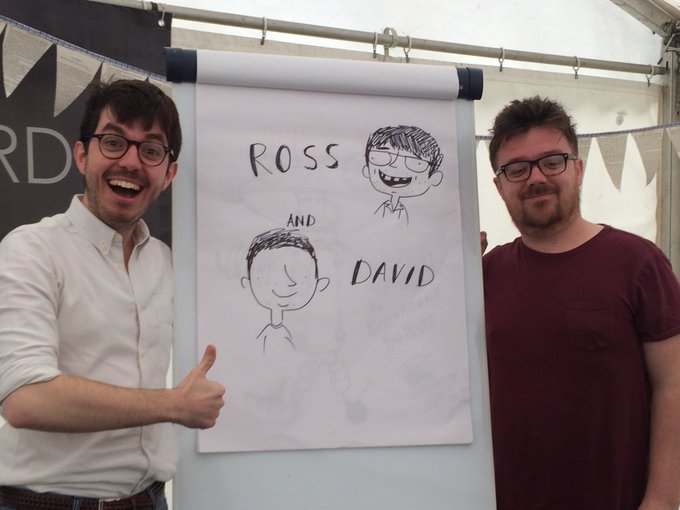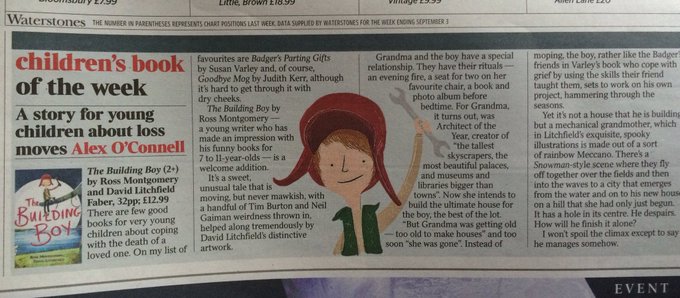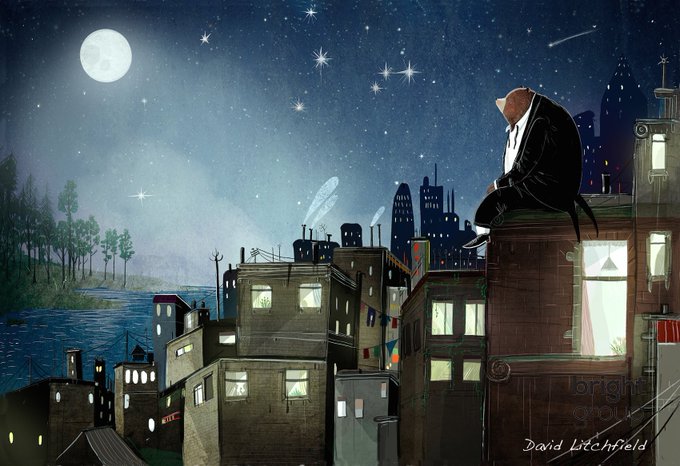The Building Boy with David Litchfield & Ross Montgomery
If you’re looking for a perfect match in both writing and illustration, there couldn’t be any better fit than Montgomery and Litchfield.
Ross Montgomery writes in a tone that speaks not only to children, but adults too. You want to listen, you absolutely want to turn the page. I discovered this on finding the first page of their first collaboration: Perijee & Me. Subsequently, I bought the book. I’m in my thirties — it’s marketed at 9-12 year olds… (Make of that what you will!) But it is so seamlessly written. It flows off the page and my somewhat addled brain, after a day of looking at a computer screen, is so relieved to get lost in this page turning tale.
Having worked with David on Perijee, it only seemed fitting that a partnership would form between author and illustrator. And so for Ross Montgomery’s debut picture book, David Litchfield’s artwork dances across the pages, with filmic vistas and imagery that makes the hairs on your arms stand up. It’s a beautiful story — a thoughtful way to describe the end of a life (a well lived one) and new beginnings for another.
We are very excited to be joined by both author and illustrator of The Building Boy in November for a story time at The Bright Emporium. It’s a chance for children to meet two people who in the future, if not already will be names to treasure as they grow older, and remember the books they loved.
Introducing Ross Montgomery and David Litchfield… LM
Ross Montgomery on writing The Building Boy
I think this is your debut picture book. It’s a beautiful story. Has this always been something you wanted to do, aside from you children’s fiction writing?
I think all children’s authors dream of making picture books! It was actually a bit of a surprise when I wrote the story — I was in the middle of writing my first MG children’s book, Alex, the Dog & the Un-openable Door, and had gone away for a “writing retreat” in a friend’s empty house for a week. I was so sick of writing the first book that one night I came up with the idea for The Building Boy and wrote it down just to clear my head — I finished the first (very early) draft in one night.
Are the characters based on real people?
There’s nothing that’s drawn directly from people I know, but while writing it I was thinking a lot about my memories of visiting my grandparents’ houses and how being with an older relative felt when I was younger. Perhaps the closest comparison would be with my grandfather, who was very practical and had an amazing cellar filled with thousands of bits and bobs that he used to make things. I found that captivating and so impressive as a child — who wouldn’t?
Who did you enjoy reading when you were growing up, and did you always aspire to be a writer, and for children, or adults or both?
I absolutely loved reading as a child, and always wanted to be a writer — with a few gaps where I wanted to be a cartoonist and then a director. My obsessions, in order, were: Beano annuals, Horrible Histories, Jacqueline Wilson, Terry Pratchett, Stephen King, which may or may not explain the kind of books I write! People have often asked if I would write a book for adults, and I’m not sure I’d know how to — the ideas that I come up with always seem to make more sense as children’s books. I also love the restrictions that come with writing a children’s book: you’re automatically given boundaries of what you can do, and the challenge is to make something new and exciting within those constraints.
Have you always written – how did it all begin?
I have no idea how I first started writing — I just remember that I always loved it. I do have an early memory of overhearing one of my parents say something very, very rude about taxes, and the next day writing down exactly what they said in a story in class. I proudly told my mum on the way home, and she slammed on the brakes, did a U-turn and sped back to school so she could change it! I had learned the power of books.
Did you study literature/journalism?
I studied English Literature and Film Studies at Sussex, which was great. I’m a slow reader, so I was effectively provided with a vast pile of amazing books and authors to explore that lasted me until I was about 28! My girlfriend is a journalist, and I’ve found her advice about brevity and succinctness invaluable — my weakness is definitely to overwrite, but I think I’m getting better about it.
I have just read the first page of Perijee and Me, and realise I need to buy it – it sounds brilliant. Can I ask – where does the name Perijee come from? (please don’t give away the story!)
Of course! Perijee & Me is about a young girl who discovers and befriends an alien, who she calls Perijee. It’s a misspelling of “perigee”, which is the name for when the moon is closest to Earth — her dad is an astro biologist and so knows a lot about space. The moon’s orbit is an ellipse rather than a circle, which means once a month it is closer than normal (the perigee) and once a month it’s as far away as it can be (the apogee) — a difference of about 50,000 miles. When you get a “supermoon” and the moon looks massive, it’s the closest perigee of the entire year!
Originally the alien was called Parsec — a measurement of space-time — but my editor told me it was rubbish and the sales team had all laughed at it! So I had to come up with a name that had to do with space, but had some other meaning to the story. I loved the idea of this phenomenon of something otherworldly coming closer than ever before and it changing everything — people say that the perigee affects us in ways we don’t necessarily notice.

Back to The Building Boy, did you have pictures set in your mind to go with the story when you wrote it?
I had a few ideas, but nothing I wasn’t happy to concede to the experts! In fact in the very first draft, the story had an open ending. I wanted the illustrator to take over and finish the story without words. I was told by my publisher that this was just laziness, which may well have been right! David and I had one meeting where we discussed each spread and how it could look, but I definitely felt it was right that as the illustrator, David should make the visual decisions and make changes when he felt something else would be better.
What’s your favourite illustration from the book?
I’ve never gotten over the double-spread of the grandmother being built over the seasons — I think it was my editor who came up with the idea, but I never could have imagined how David’s final version would turn out. It’s breathtaking! I also love the cityscape scene — it’s very telling that whenever I do an event and show the children that image, it gets an audible response. 
What is next on the horizon for you?
I’m much busier than normal at the moment — David and I have another picture book out next years called Space Tortoise which I’m very excited about, but I’m also currently writing two other books! They’re both aimed at the 9-12 range: one is about a boy who discovers a microscopic, epic civilisation on his bedroom floor and becomes their god, and another is a collection of short horror stories to be read at Christmas! By the end of 2017 you’ll all be sick of me.
Faber and Faber on publishing The Building Boy
“Ross’s text is brilliantly beautiful and gentle, so we knew we needed an illustrator who could not only match the text’s tone, but also really bring out the warmth and magic in it too. Also, a book about a grandma passing away has the potential to be a very sad read for children, so we needed to make sure that the illustrator could lighten the tone a little. Needless to say, when we saw David’s work, we knew he was perfect! His characters are soft and friendly without ever being cartoony, and his colour palette is is sensationally rich, but also wonderfully muted – it has an almost vintage feel – which means that the art really matches the tenderness of the text. David is also an expert in depicting light – ideal for portraying the cosiness of the scenes between the boy and his grandma, but also the beauty and awe of the night skies. We are so proud and thrilled to publish THE BUILDING BOY and think Ross and David are a perfect partnership – here’s to many more books between the two!”Naomi Colthurst, Commissioning Editor at Faber Children’s and on behalf of the team who worked behind the scenes of The Building Boy.
David Litchfield on drawing The Building Boy
When you illustrate a story, where do you begin? And when you come to illustrate the final artwork, do you start from beginning to end, or do you pick a page you feel strongly about – how does it work?
I start by making hundreds of really rough sketches in my sketchbook. I try to draw in my sketchbook with the knowledge that no one will ever see what I draw as this frees me up from any inhibitions I have about what I’m drawing. From this I get a good idea of the look of the characters, and then I can start planning out the entire book in thumbnail sketches. Again, these are very quick and free drawings, just a way of visualising the story and plotting the pace and so on. Once this is done I go back over all of the sketches and start developing them further and start creating a more coherent ‘rough’ version of the book. When it comes to putting the artwork together I always start with whatever page I’m most excited about visually. For The Bear & The Piano that was the big giant theatre scene and for The Building Boy it was page with the giant grandma holding the boy aloft in the moonlight. I like to start with these big, ambitious and bold pages because then I think all of the other pages have something to live up too. It’s a bit of a self-inflicted challenge to myself as I work on the book. 
Do you mainly work in photoshop? Your use of light and layering of colour is so stand out. There really is no one else with a style similar. Did it take you a long time to develop this style, and to learn photoshop and/or illustrator?
I create a lot of textures in my sketchbooks and scan those in, and most of the initial drawings are also created in my sketchbooks. I then combine all of these in Photoshop. It’s a lot of trial and error and experimenting to find out what works best visually. The thing with light is that I have always been drawn to art that uses dramatic lighting effects but it is only since fairly recently that I have been using light in my own work. I think one of the people who has influenced me there is Steven Spielberg. I love how he uses light in a really emotional way — particularly in films like ET and Close Encounters of the Third Kind.
I love the font/typography you use which has become quite trademark I think – did you make it yourself?
Do you know what, when I drew the cover for The Bear & The Piano I wrote the title in my own handwriting over the top of the image just to show the designer where I thought the text should be placed. To my surprise they really liked it and kept it in my rough handwriting. Then, not long after, the exact same thing happened when I sent the drawings over for the book cover for another one of Ross’s books — Perijee & Me. I just quickly drew it to show the placement and the designer said they really liked it, so that stayed too.
Did Ross have an idea of what he wanted the characters to look like, or were you able to create your own vision of his story totally from scratch?
Well, we had a few email discussions and one face to face meeting. I showed him some of the sketches I had and he seemed to like them. It’s always fun working with a writer because they will have their own ideas about the look of the book, as they should — because they created that world after all — and as an illustrator you will also have your own interpretation on the text. I think it’s when you meet in the middle and combine each others ideas that good things start to happen. Ross had a few ideas that I hadn’t thought about and visa versa.
How did you and Ross get together on this project?
Thanks to the lovely agents at Bright, my portfolio found its way into the office of Faber & Faber. The editors of Ross’s books really liked some of my early drafts from my bookGrandad’s Secret Giant and could see visual parallels with what they wanted for The Building Boy. I think they also saw a connection between Ross and me, in that we are both a little bit odd and we like odd things ![]()
What’s your favourite illustration from the book? (I think mine is actually the very last page – although I also love the filmic spreads of their journey)
I actually really like the first spread of the boy sitting on Grandma’s knee. It’s like a really loving and innocent spread were they both look so content and happy and are completely unaware of what is to come. So in many ways its a bit of a heartbreaking picture, but also full of love. And I just really like it.

What is next for David Litchfield?!
Well, this year was super exciting and I have been working on a lot of new projects that will all come out in 2017. My second author/illustrator book Grandad’s Secret Giant will be out in April 2017. It’s very different from The Bear & The Piano so I can’t wait to see what people think of it. Then later in the year there is a book I drew for Teresa Heapy called The Marvellous Moon Map which is a beauty. Then the second picture book project with Ross called Space Tortoise which is hilarious and very sweet indeed.
And then whilst all of that is going on, I will also be getting on with some brand new projects including books which are about a famous musical duo; a dog who wears a lot of hats; and a fantastical, surreal journey of a granny and her granddaughter. I’m super happy to say I will also be working on another book featuring my piano playing bear.
So, it’s going to be a bonkers, but very happy year and a bit.
If you’d like to work with David Litchfield, you can get in touch via his agent, Anne Moore Armstrong, here.
You can also contact Ross Montgomery here.

Storytime at The Bright Emporium…








